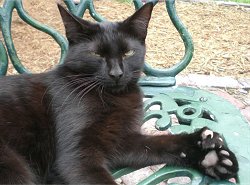Hemingway Cats

Key West Hemingway Home in Florida is one of the most frequently visited museums in the United States. But the former home of the great writer does not only attract visitors with its museum exhibits. The present residents of the home are also a great attraction. Hemingway Key West is home to approximately 60 cats, most of them polydactyls (cats which have more than the usual five digits in the front paws or more than 4 digits on the back paws). Many of these cats are direct descendants of a six-toed cat named Snowball, an unusual cat which Hemingway received from Stanley Dexter in the 1930s. Although Hemingway was not previously known to be particularly fond of cats, Snowball won his heart. Hemingway was apparently fascinated by the polydactylism in cats and a small colony grew up in Key West. When Hemingway's died his former residence became a home for his cats, which roam freely around the grounds. They can be frequently found in the house, in the master bed room, or sprawled on the floor of the gift shop. Travel writer Michael Palin, in a recent program called "Hemingway Adventure" commented that the cats are definitely a bigger attraction than Hemingway. They lighten up what is otherwise a pretty lifeless series of rooms, and they give the guides something to talk about.
The Hemingway cats are looked after by the staff. All cats have somewhat unusual names, being called after celebrities. So visitors to the Hemingway home may come across Pablo Picasso, Trever Howard, Sofia Loren or Charley Chaplin watching them intently or snoozing from under a nearby tree. Most of the cats are neutered, but staff like to keep one or two of these cats un-neutered so they can have a steady turnover of generations in the family. The cats are frequently visited by the local vet and given appropriate vaccinations and other necessary treatments.
Recently the Hemingway cats got into trouble with the US Department of Agriculture. Apparently the USDA has determined that the Key West resident free-range felines are 'display animals' like those in a zoo, and under the guidelines in the appropriate section of the Animal Welfare Act that deals with 'animal exhibitors' they must be caged. USDA officials claim that the cats leave the grounds of the home and are a nuisance to the neighbours. However, they will not disclose the source of the complaints, or even how many they have received.
Museum chief executive Mike Morawski has been in the discussions with USDA for over 4 years now. As a result the Hemingway property is now not only surrounded by a solid wall but there is also an angled fence atop the perimeter wall to prevent the cats leaving the property. But that is still not enough for the USDA. Although the USDA is still insisting on cages all round cats, the residents of Key West side with the cats. One resident, Tom Coward, owner of the Andrews Inn guesthouse that borders the Hemingway museum said: "You'd think the city has bigger problems than this to deal with. We certainly didn't complain about the cats. In fact, I miss them coming into the garden since the museum put the fence up. They're not a nuisance, they're neutered and they're well cared for."
So far, while the Hemingway home staff battles in the courts, the cats go about life serenely unaware of the problems they, (or alternatively, the US Department of Agriculture) have caused.
A petition to save the Hemingway cats can be found here - http://www.petitiononline.com/MCPI/petition.html

